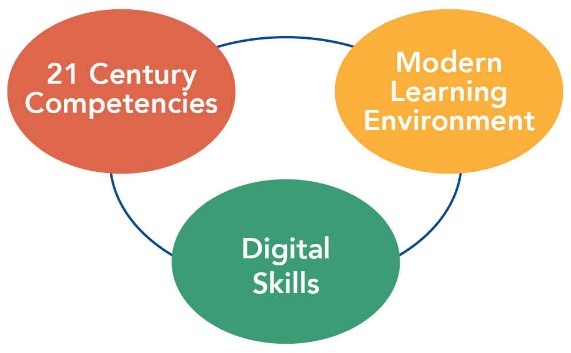
HWDSB 21st Century Learning Strategy
Vision
HWDSB graduates acquire the competencies and digital skills needed to successfully pursue a post-secondary pathway (apprenticeship, college, community, university, or the workplace) and find success in an ever-changing economy and society.
Goal
Learning for Tomorrow provides guidance to educators on the development of modern learning environments where educators support students to develop 21st century competencies and digital skills. The strategy complements and enhances existing HWDSB strategic directions and strategies (e.g. The Early Reading Strategy and All Students Graduating Strategy).
Learning for Tomorrow is primarily modeled after the International Society for Technology (ISTE) 2016 Standards for Students, which is currently the gold standard for “learning, teaching, and leading in the digital age”. The standards are updated approximately every ten years and are based on extensive research and consultation.
According to the ISTE:
At their core, the ISTE Standards are about pedagogy, not tools. Which is to say, they emphasize the ways that technology amplifies and even transforms learning and teaching. The field of education now realizes the insufficiency of throwing digital tools into classrooms without further support and expecting valid changes in teaching and, more importantly, improved student outcomes.
Implementation
Students will begin to develop 21st century competencies and digital skills from the first day of kindergarten through to secondary school graduation. To accomplish this, educators will provide students with developmentally appropriate learning experiences in virtual and physical environments from kindergarten to grade 12 that intentionally fosters 21st century competencies and digital skills. Learning for Tomorrow will be embedded in the framework of the Ontario Curriculum, with learning experiences reframed to better incorporate the development of 21st Century competencies and digital skills.
Core Components
Learning for Tomorrow consists of three core components:
- 21st century competencies
- Digital skills
- Modern learning
21st Century Competencies
Students will acquire the competencies outlined in the HWDSB 21st Century Learning Policy:
- Creativity, Innovation, and Entrepreneurship: Students are creative thinkers who construct knowledge and develop innovative products and processes;
- Communication: Students communicate, in the physical and virtual worlds, effectively to support their learning and contribute to the learning of others;
- Collaboration: Students collaborate with to learn, advance ideas, co-create new knowledge, and achieve learning goals;
- Learning to Learn: Students are aware of their learning strengths and needs, and how to learn most effectively in virtual and physical spaces;
- Critical Thinking: Students use critical thinking skills to plan and conduct inquiry-based research, manage projects, solve problems, and make informed decisions using appropriate digital tools and resources;
- Global and Digital Citizenship: Students understand human, cultural, and societal issues related to citizenship, appropriate use of technology, as well as practicing legal and ethical behaviour.
Digital Skills (ISTE Technology Scope)
Students will have opportunities to acquire the following digital skills:
- Basic Operations and Concepts. Example: Turn on/off a computer
- Logins/File Management. Example: Use login credentials
- Personal Data Management. Example: Protect accounts by logging out
- Online Safety. Example: Understand how to practice safe Internet searches
- Digital Identity. Example: Build a positive digital footprint.
- Keyboarding. Example: Learn to use special characters as needed.
- Painting and Drawing Programs. Example: Use basic design principles
- Communication and Collaboration
- Tools. Example: Utilize collaborative workspaces and documents.
- Word Processing. Example: Create, format, edit, and print a document
- Problem solving and Computational Thinking. Example: Use a block-based visual programming interface to build a game, tell a story, or solve a problem.
- Spreadsheets and Databases. Example: Create spreadsheets to manage data.
- Multimedia and Presentation Tools. Example: Create a series of slides and organize them to present research.
- Internet Searching and Online
- Databases. Example: Locate the URL of a website and make a distinction between the suffixes .org, .ca, .EDU, . net, and international domains.
- Acceptable Use, Copyright, and Plagerism. Example: Transfer the information learned from online sources into your own words.
- Organizational and Project Tools. Example: Use a calendar, task manager, or other tools to organize one’s self as well as manage projects.
Modern Learning Environment
Students will acquire competencies and skills in learning environments that are:
- Blended: where learning can be in person, on-line, or a blend of the two;
- Modern: where schools are equipped with a variety of developmentally appropriate learning tools and resources, including digital devices;
- Local and Global: where learning occurs both in and out of the classroom and in and out of the school; and, considers local and global issues and problems;
- Experiential: where students learn from experiences (e.g., excursions, experiments, and cooperative education placements);
- Personalized: where student interests, identities, and abilities are valued and considered in the classroom;
- Success Oriented: where the process of learning (assessment) rather than the product of learning (evaluation) is the focus;
- Intentional: where global competencies are explicitly taught, named and noticed when being developed or demonstrated.
Updated on Thursday, June 18, 2020.

